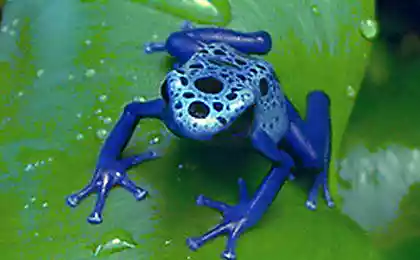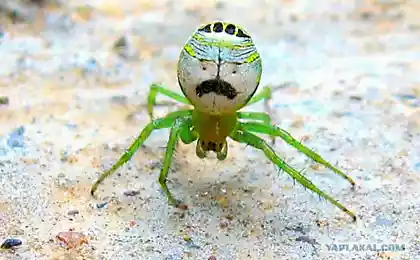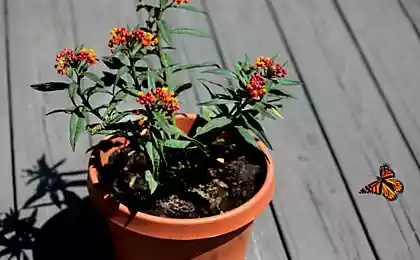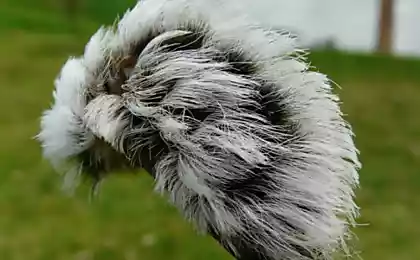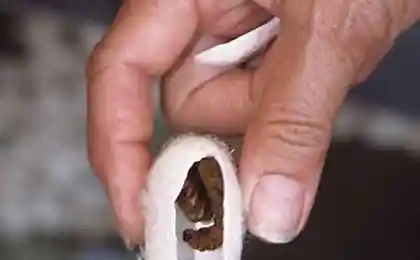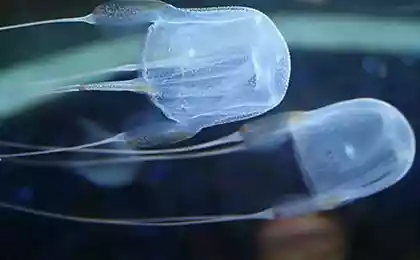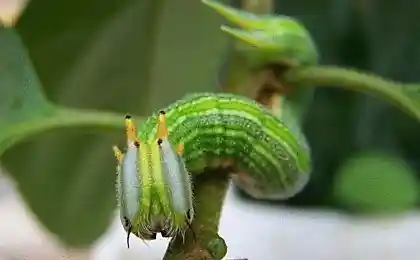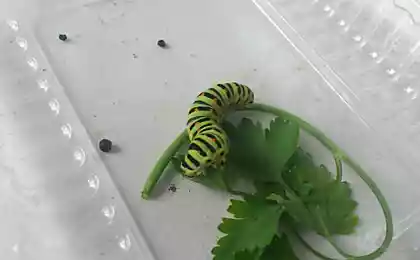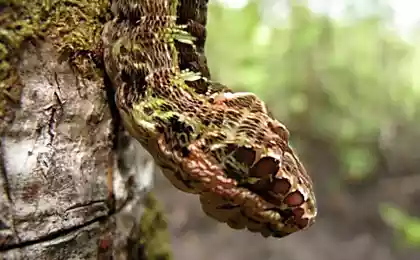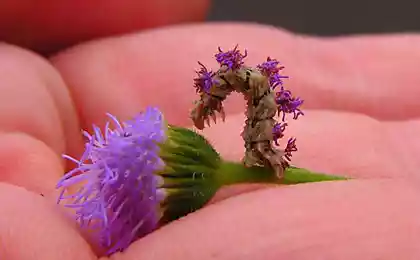244
Caterpillars that can kill
Do not be fooled by the appearance of these bizarre and charming caterpillars. Many of them will do anything to protect themselves and their food from predators. Their brightness most often indicates poisonousness, and the hairs and spines contain a toxic cocktail. Here are some beautiful but dangerous caterpillars to stay away from.
1. Coquette caterpillar (Megalopyge opercularis)
The caterpillar-coquette looks like a miniature fluffy animal. However, once you touch it, you will have an unpleasant surprise.
Poisonous spikes hidden under its “wool” release poison, causing severe throbbing pain that can radiate into the armpit, five minutes after contact with the caterpillar. At the place of touch, red erymatous spots may appear. Other symptoms include: headache, nausea, vomiting, abdominal discomfort, damage to the lymph nodes, sometimes shock or difficulty breathing.
The pain usually subsides after an hour, and the spots disappear after a few days. However, with a large amount of poison, symptoms can last up to 5 days.
2. The Saddle Caterpillar (Sibine Stimulea)
Saddle caterpillar attracts attention with its bright color, and believe me, you better stay away from it. Her fleshy horns are covered with hairs that secrete poison.
Touching them will cause pain similar to a bee sting, swelling, nausea and a rash that will last for several days.
3. Caterpillar "Scorching Rose" (Parasa indetermina)
The caterpillar "burning rose" reaches a length of only 2.5 cm and has a bright color. But apart from its yellow and red spots, its thorny bumps protruding from different sides are the most attractive.
The tips on these bumps, as you might guess, release poison. If you touch one of them, the tips will break off and you will have skin irritation.
4. The prickly oak caterpillar of the slug (Euclea delphinii)
This caterpillar is not as dangerous to humans, although touching it will still lead to a rash. This is due to the spiny bumps located on the back and sides.
As a rule, these caterpillars live on oaks, willows, as well as beech, cherries, maple and other deciduous trees.
5. The caterpillar of the crossbear (Tyria jacobaeae)
Some caterpillars acquire toxicity through the plants they eat. And this applies to the caterpillars of the crossbear, which feed on a poisonous crossbread.
They eat so much of this plant that they are used in New Zealand, Australia and North America to control the growth of the crossbow. This plant is deadly to cattle and horses, and for people pose a certain threat to health.
If you are susceptible to caterpillar hairs, touching it can cause hives, atopic bronchial asthma, kidney failure, and brain hemorrhage.
6. Caterpillars of the hiking silkworm (Thaumetopoea pityocampa)
Hiking silkworm caterpillars live in groups in large silk nests high on pine trees.
They follow each other from nest to pine needles in search of food. As you can see, contact with them is dangerous. They are covered with thousands of tiny hairs in the form of harpoons, touching which causes severe skin irritation.
7. The caterpillar “covering in a bag” (Ochrogaster lunifer)
Like hiking silkworm caterpillars, they live in groups in a silk bag, going out at night and following each other in search of food. However, the danger from them is greater.
In South America, they are a health threat. The poison in their bristles is a powerful anticoagulant. This means that if you accidentally touch them, you risk bleeding from a small cut or internal bleeding.
8. Caterpillar Saturnia io (Automeris io)
This caterpillar is found in Canada and the United States, and although it looks like a charming crumb with green spike pompoms, remember that you can only admire them.
As tiny as their spines may seem, the venom they contain can cause painful itching and even dermatitis.
9. The Mole-Witch Caterpillar (Phobetron Pithecium)
If you thought that the caterpillar-coquette looked quite unusual, admire this furry creature. The mole-witch caterpillar, also called the slug monkey, often lives in orchards.
People have different susceptibility to these caterpillars and in some they cause unpleasant symptoms, including itching and rashes.
10. The caterpillar of the hickory bear (Lophocampa caryae)
It seems as if these caterpillars were dressed in winter fur coats. Most of the hairs that cover their body are pretty safe, but they have four long black hairs in front and back that are worth walking around.
Touching them leads to rashes and more serious health problems if hairs get into the eyes. Besides, they still bite.
11. The Lazy Clown (Lonomia Obliqua)
This caterpillar of a peacock-eyed butterfly can be safely called a killer caterpillar. Its spines are filled with poison coagulant - an anti-coagulant substance that can lead to human death.
Light touching these caterpillars can lead to headache, heat, vomiting and, in the absence of treatment, internal bleeding, kidney failure and hemolysis.
Their venom is so powerful that scientists are studying it in hopes of developing a drug that prevents blood clots from forming.
12. The caterpillar moth "white cedar" (leptocneria reducta)
This caterpillar with its appearance already inspires fear. The hairs of this tiny crawling “cactus” can cause an allergic itching reaction in some people.
In addition, the caterpillars themselves live in large groups, teeming on the tree at the same time, and eating every single leaf before moving on.
13. Caterpillar of Saturnia Maya (Hemileuca maia)
One look at this caterpillar should discourage you from wanting to touch it. It is covered with hollow spikes attached to a poisonous sac, and touching it will not only cause itching and burning, but also lead to nausea.
They live mainly on oaks and willows from spring to mid-summer.
14. Caterpillar of the Wave (Orgyia leucostigma)
This caterpillar is easy to spot because of the red head, black back and yellow stripes on the sides. Besides being unpleasantly stinging, this caterpillar is considered a pest of trees, eating all the wood in its path.
But try to remove it from the power source, and you will not be happy.
P.S. And remember, just changing our consumption – together we change the world!
Source: do-you-speak.livejournal.com/feed/?skip=60
1. Coquette caterpillar (Megalopyge opercularis)
The caterpillar-coquette looks like a miniature fluffy animal. However, once you touch it, you will have an unpleasant surprise.
Poisonous spikes hidden under its “wool” release poison, causing severe throbbing pain that can radiate into the armpit, five minutes after contact with the caterpillar. At the place of touch, red erymatous spots may appear. Other symptoms include: headache, nausea, vomiting, abdominal discomfort, damage to the lymph nodes, sometimes shock or difficulty breathing.
The pain usually subsides after an hour, and the spots disappear after a few days. However, with a large amount of poison, symptoms can last up to 5 days.
2. The Saddle Caterpillar (Sibine Stimulea)
Saddle caterpillar attracts attention with its bright color, and believe me, you better stay away from it. Her fleshy horns are covered with hairs that secrete poison.
Touching them will cause pain similar to a bee sting, swelling, nausea and a rash that will last for several days.
3. Caterpillar "Scorching Rose" (Parasa indetermina)
The caterpillar "burning rose" reaches a length of only 2.5 cm and has a bright color. But apart from its yellow and red spots, its thorny bumps protruding from different sides are the most attractive.
The tips on these bumps, as you might guess, release poison. If you touch one of them, the tips will break off and you will have skin irritation.
4. The prickly oak caterpillar of the slug (Euclea delphinii)
This caterpillar is not as dangerous to humans, although touching it will still lead to a rash. This is due to the spiny bumps located on the back and sides.
As a rule, these caterpillars live on oaks, willows, as well as beech, cherries, maple and other deciduous trees.
5. The caterpillar of the crossbear (Tyria jacobaeae)
Some caterpillars acquire toxicity through the plants they eat. And this applies to the caterpillars of the crossbear, which feed on a poisonous crossbread.
They eat so much of this plant that they are used in New Zealand, Australia and North America to control the growth of the crossbow. This plant is deadly to cattle and horses, and for people pose a certain threat to health.
If you are susceptible to caterpillar hairs, touching it can cause hives, atopic bronchial asthma, kidney failure, and brain hemorrhage.
6. Caterpillars of the hiking silkworm (Thaumetopoea pityocampa)
Hiking silkworm caterpillars live in groups in large silk nests high on pine trees.
They follow each other from nest to pine needles in search of food. As you can see, contact with them is dangerous. They are covered with thousands of tiny hairs in the form of harpoons, touching which causes severe skin irritation.
7. The caterpillar “covering in a bag” (Ochrogaster lunifer)
Like hiking silkworm caterpillars, they live in groups in a silk bag, going out at night and following each other in search of food. However, the danger from them is greater.
In South America, they are a health threat. The poison in their bristles is a powerful anticoagulant. This means that if you accidentally touch them, you risk bleeding from a small cut or internal bleeding.
8. Caterpillar Saturnia io (Automeris io)
This caterpillar is found in Canada and the United States, and although it looks like a charming crumb with green spike pompoms, remember that you can only admire them.
As tiny as their spines may seem, the venom they contain can cause painful itching and even dermatitis.
9. The Mole-Witch Caterpillar (Phobetron Pithecium)
If you thought that the caterpillar-coquette looked quite unusual, admire this furry creature. The mole-witch caterpillar, also called the slug monkey, often lives in orchards.
People have different susceptibility to these caterpillars and in some they cause unpleasant symptoms, including itching and rashes.
10. The caterpillar of the hickory bear (Lophocampa caryae)
It seems as if these caterpillars were dressed in winter fur coats. Most of the hairs that cover their body are pretty safe, but they have four long black hairs in front and back that are worth walking around.
Touching them leads to rashes and more serious health problems if hairs get into the eyes. Besides, they still bite.
11. The Lazy Clown (Lonomia Obliqua)
This caterpillar of a peacock-eyed butterfly can be safely called a killer caterpillar. Its spines are filled with poison coagulant - an anti-coagulant substance that can lead to human death.
Light touching these caterpillars can lead to headache, heat, vomiting and, in the absence of treatment, internal bleeding, kidney failure and hemolysis.
Their venom is so powerful that scientists are studying it in hopes of developing a drug that prevents blood clots from forming.
12. The caterpillar moth "white cedar" (leptocneria reducta)
This caterpillar with its appearance already inspires fear. The hairs of this tiny crawling “cactus” can cause an allergic itching reaction in some people.
In addition, the caterpillars themselves live in large groups, teeming on the tree at the same time, and eating every single leaf before moving on.
13. Caterpillar of Saturnia Maya (Hemileuca maia)
One look at this caterpillar should discourage you from wanting to touch it. It is covered with hollow spikes attached to a poisonous sac, and touching it will not only cause itching and burning, but also lead to nausea.
They live mainly on oaks and willows from spring to mid-summer.
14. Caterpillar of the Wave (Orgyia leucostigma)
This caterpillar is easy to spot because of the red head, black back and yellow stripes on the sides. Besides being unpleasantly stinging, this caterpillar is considered a pest of trees, eating all the wood in its path.
But try to remove it from the power source, and you will not be happy.
P.S. And remember, just changing our consumption – together we change the world!
Source: do-you-speak.livejournal.com/feed/?skip=60
Stunning beauty GIF animation: the Moon passing against the background of the Earth
Mogolia? or I can't







